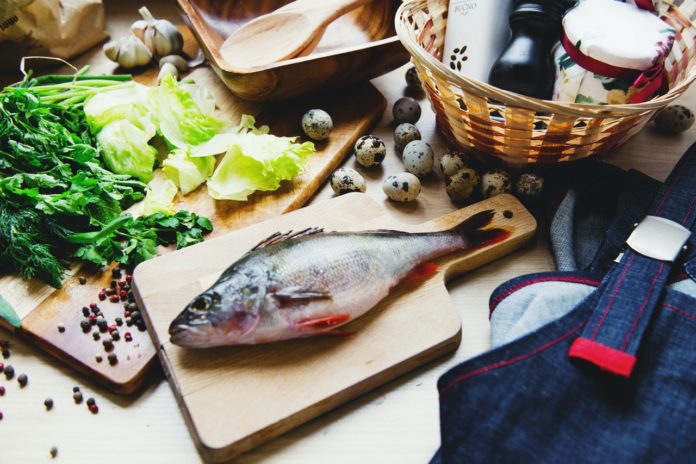If you’re planning to have a lighter, healthier menu for today’s lunch, choosing seafood for your entree is a smart choice. Compared to poultry and red meat, seafood is known to be a healthier source of protein — until they’re cooked in such a way that diminishes their nutritional benefits. We’re talking about breading, deep-frying, overseasoning with salt and sugar, overloading it with cheese, and drenching in butter.
Want to make healthier choices today? We’re here to offer 8 ways to make your seafood dishes bursting with health benefits without sacrificing the flavor.
1. Cook or serve seafood with “superfoods”
Nutritionists claim that there’s no such thing as a “superfood” – it’s just a term coined for marketing purposes. No food is guaranteed to make you live for more than a century, and be immune from chronic diseases. Some foods, however, are worthy of the title because of their impressive nutritional profile.
Give your seafood dishes a huge nutritional boost by cooking them with foods packed with high amounts of essential vitamins and minerals. Among the world’s healthiest foods include dark leafy greens (kale, spinach, collard greens, turnip greens, swiss chard), berries, broccoli, garlic, ginger and turmeric, avocado, legumes (soy, lentils, peas, and peanuts), sweet potato, and olive oil.
You can cook your seafood first then serve them as side dishes, like a salad or dessert. You can also cook your seafood with these superfoods in a form of stew and soup.
2. Season your dish with herbs and spices
What’s good about fish and shellfish is they have a natural, delicate saltiness. You just need to get them from a high-quality seafood market, throw in a pinch of salt and pepper to season them, and they’re good to go. But hey, what’s life without herbs and spices?
Common kitchen herbs (like parsley, thyme, basil, rosemary, mint, oregano), cinnamon, paprika, ginger, garlic, turmeric, and peppers are just a few of the power foods you should have in your pantry.
Herbs and spices aren’t just a way to add robust flavor to your dish without reaching for the salt shaker more often. They are also packed with antioxidants and other nutritional benefits, making your seafood dishes tastier while boosting your health.
3. Prepare the grill
Grilling is a direct-heat cooking method wherein the heat comes from the bottom. You might need to lightly brush the fillet with olive oil to prevent it from sticking. If you’re using a traditional grill, place it away from the hottest part of the fire so it doesn’t overcook. Check for color and doneness after a few minutes. Flip it when you see grill marks forming.
4. Broil your seafood
Broiling is a no-oil cooking method that exposes the fish to direct heat in the oven. Unlike grilling, the direct heat comes from the top. One of the best fishes to broil is salmon since its natural oils prevent the flesh from drying. Other oil-rich fish options include tuna, sea bass, and mackerel. If you’re planning to use leaner cuts of fish, you may marinate them before broiling.
5. Try the poaching method
Poaching is a method wherein your fish is cooked in a simmering liquid. The healthier your liquid is, the better your result will be. Options may include fish stock and water ceased with garlic, onion, ginger, and other herbs and spices.
To cook, simmer the fish using the liquid until the center is opaque, then remove it with a slotted spatula.
6. Steam your seafood
Steaming is a cooking process that does two good things for you: it cooks your fish without requiring added fat and it cooks your fish without drying out the flesh. You just need to have kitchen equipment that holds the fish, allowing it to steam. A steamer basket, which rests above a pot of boiling water, is one.
Steamed fish is best paired with a flavorful sauce infused with herbs and spices. Again, the healthier sauce, the better.
7. Bake to enjoy a crisp exterior without the added oil
Baking is the simplest method for cooking fish. For a basic baked fish, season the fish with salt, pepper, and other herbs and spices. You may even squirt some lemon or lime. Arrange the fillets on a baking sheet and cover them with parchment paper. It takes 7 to 10 minutes per inch of thickness to bake them.
Baking also allows you to have that satisfying crisp exterior you love about fried fish sans all the fat. Just be mindful of the amount of oil, cheese, mayonnaise, and butter the recipe requires.
8. Opt for a healthier oil
Who doesn’t love shrimp and crabs in garlic butter sauce? People from east to west love buttered seafood and have their own take on this beloved classic. But butter as we know it isn’t the healthiest source of fat if you’re watching your cholesterol levels.
The cooking methods listed in the last five topics (grilling, broiling, poaching, steaming, and baking) use zero to little oil. But if your recipe calls for lots of oil, the least you can do is to skip the butter and opt for healthier oil options. For a healthier take, you may use plant-based, nutrient-packed alternatives like olive oil, coconut oil, and nut and seed butter.
Bottomline
Seafood is healthy – until you drench it in flour, salt, and oil. We love tempura, fish and chips, and deep-fried calamari but we love our health even more. Do you have a healthy cooking method for your favorite seafood? Feel free to share it with us.
Author Bio: Mina Natividad is a passionate daytime writer for Manettas Seafood Market, an online and interactive seafood hub which provides customers a true, first-class fish market experience without leaving home. Since she’s a seafood lover herself, she’s got a lot to say about food, well-being, and lifestyle.









